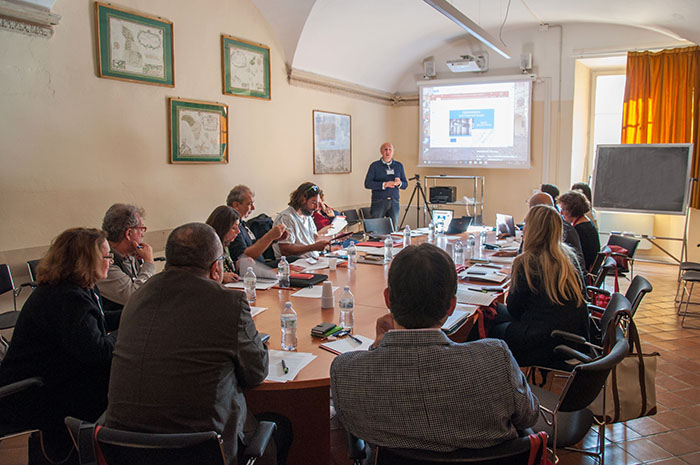The BYZART project: creating one of the widest online collections of Byzantine art and archaeology
Introducing a new Generic Services project to digitize and promote Byzantine art and archaeology, led by the BYZART consortium

- Title:
- Byzantine Generic Services kickoff Bologna 31 October 2017
- Creator:
- Giulia Marsili
- Date:
- 2017
- Institution:
- Università di Bologna
- Country:
- Italy
- Copyright:
- CC BY-SA
Written by Giulia Marsili, PhD, Università di Bologna
In October 2017 the BYZART project was launched and two kick-off meetings took place. They represented remarkable occasions to share knowledge about Europeana strategies and resources, as well as about goals and ambitions of the BYZART project. Funded as a part of the 2016 Generic Services call, this project aims to digitize, catalogue and make available rich archive collections about Byzantine cultural heritage in Europeana.
Byzantine culture is one of the milestones of European cultural heritage. For centuries, it spread all over the Mediterranean a homogeneous civilization despite regional diversities with strong influence over later European artistic and cultural expressions. Nevertheless, nowadays the wide heritage of the Byzantine art in Europe is undervalued, even if each Mediterranean region preserves remarkable memories and traces of its Byzantine past. The BYZART project proposes to raise awareness about this impressive heritage, by showcasing collections of archive photographs, audio-visual materials and 3D reconstructions in Europeana Collections. We aspire to utilise and building upon existing Byzantine content already in Europeana.
On 3rd October, Giulia Marsili and Lucia Orlandi from the University of Bologna, the BYZART technical coordinators, were welcomed to Europeana Foundation offices in The Hague. During the session, they presented the consortium and its member archives. The Europeana team introduced their guests to the thematic collections strategy, publications strategy, ingestion process and editorial features such as exhibitions, galleries, and blogs. All the suggestions received in this very inspiring meeting were taken and later brought up in the first official consortium meeting.
On 31 October this second kick-off meeting took place at the Department of History and Cultures of the University of Bologna and gathered all the partners for the first time. It was a wonderful occasion to brainstorm every aspect of the project. Partners’ collections, digitization procedures and best practices on metadata structure, the BYZART web platform, editorial features, audiences and recruitment of new data providers were only some of the topics we addressed during this intensive and fruitful day.

One of the most exciting topics was the variety of partners archive collections. Their subjects range from architecture, sculpture and archaeologý to pictures, icons and manuscripts, covering a really broad chronological (from 3rd to 15th century) and geographical span (all over the Mediterranean). Besides images, drawings, graphics, sketches and videos about Byzantine history, audio recordings about Byzantine church music and 3D reconstructions of Byzantine monuments will be included in the collection. The chance to digitize new materials represents a great occasion in getting highest quality materials, to which data providers will devote great efforts. We are aware that the acquirement and the sharing of more than 75,000 items will be a great challenge, but we are ready to face it!
We also focused on copyright and explored different ways to make as more content as possible available for reuse in different priority markets, such as academia, education, tourism and creative industries. In this way, the project hopes to create one of the widest existing collections of Byzantine art and archaeology within Europeana platform and open it up to new data providers which can contribute their Byzantine collections. If you are one of them, don’t hesitate to contact us at [email protected] – we are waiting for you!
